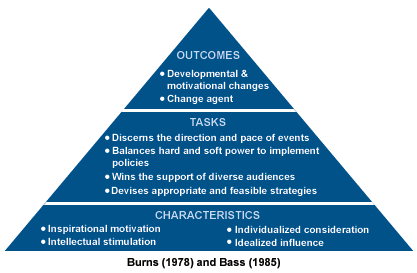Working ON Your Business not IN Your Business
The pressure on directors and leaders to be not only great role models but also to be involved in every aspect of the business is relentless. But successful leaders in any sector, no matter their personality or background, can't be everywhere and know everything. Those that try quickly suffer from stress and burnout. Trying to be everything to everyone is exhausting and futile.
Successful leaders have the ability to focus ON their business rather than IN their business. What that means in reality is that they do not loose sight of their most important role, that of leading their people and organisation. Here are some of reasons why directors get sucked into their business so easily, and what to do about it.
Directors: Being Pulled from Pillar to Post
The urge for directors to jump in to your business as the chief fire-fighter or executive management is the most natural reaction any director or owner has when it is under pressure to demonstrate their leadership. 'Keep calm I'm in charge' is the key message leaders want to portray. That position of fire-fighter extraordinaire (superman without the lycra) the man (mainly) who can, is a powerful pull to keep leaders hands on, but its also one main reason why companies don't succeed.Directing is what a business expects directors to do in demonstrating their leadership skills. From making the big decisions through to setting an outstanding example to others, the pressure is always on to be seen be in the control and to be the ultimate arbitrator of problem solving. The problem is that while firefighting looks and feels vitally important, spending time working out why things have gone wrong is actually what is ultimately important, and what we directors should be investing our time and energies on solving.
The hardest task in doing the right thing as a leader is to know how and when to stand back and not get drawn into the day-to-day stuff in any business. By ensure they stay directing, not doing, and making the future happens successfully. It's always easier to pick up someone else's ringing phone rather than educate them to do do it. But in doing so you've just become a firefighter rather than a director directing. Successful leaders have to learn how to stand back and understand what is happening and why. They must learn that their actions in directing people lead to the results they can see. To change their people's behaviour which leads to a change their activity and outcomes requires leaders to change their behaviours first.
Being a director is an official role, often a badge of great success and a role of not only legal significance but also as a role model of leadership. Leadership, the act of leading is about directing others towards an agreed shared goal, and that is where leaders deliver results. Leadership is a action, an interaction in how leaders support and serve their people, not a title but a series of actions which impact upon others.
The best leaders are the not the ones people see, but like great teams, from sports teams to kitchen chefs, where everything happens as if by magic and no-one can see how it is done. But like a great orchestra everyone knows their place, their role and how they contribute to the overall success of the business.
Work: ON it! Not IN it!
Working ON the business, deciding where the organisation is going and why rather than IN, getting stuff done, is where people really see the value of an effective leader. That requires leaders to focus on both where they are going as well as how they a business is operating in getting to that destination.The biggest mistake leaders can make is wanting to be seen to be busy in the business. Being seen as doing something within the company process, directly adding to the value chain, while it is being seen can lead to the leadership looking sight of its real role, that of leading not working in. Being a 'hands on' person is one of the classic perceptions which people inside a company feel they need to deliver to be valued.
While stepping in to pacesetter is a good tool, it most often pulls directors out of their role and means they become a boss not a leader.
Directors Need to Be Seen to Lead
I've just worked with an advanced manufacturing client to develop an operations director who said in response to my suggestion: "I can't be seen to sit down and read how to do something new, I have to be busy doing something so all my people can see me working hard." This classic trap, of having everyone working IN their business leaves no-one working ON their business. It's an example of the classic challenge for leadership of being seen and being seen to be busy.Being seen and involved in everything is part of being in charge, and able to offer advice, make decisions and drive people towards their objectives. The effect of having to be always seen is that directors have to be first to arrive and last to leave, draining the batteries of many directors particularly in rapidly changing companies.
Where being seen becomes the culture of leadership, suddenly everything has to be run past them which leads to vertical management structures, creating a lack of empowerment throughout the organisation which results in reduced moral and hierarchy control, putting further pressure on directors and undermining ownership as deference to authority becomes the normal acceptance. This change makes all decision making hierarchical, creating control and in result reducing flexibility to respond to changes, which no-one, the leadership, is now looking out for.
The other common problem with being seen all the time, having your door open at any time is that directors become the only people able to make decisions, resulting in increased pressure on directors to know what is going on. This pull factor into the day-to-day and the politics of micromanagement eats resources and kills innovation.
Successful leaders understand the importance of being seen effectively in business today is more about communicating when you are available and that you are available to them to provide dedicated support not just being there for people. Being seen therefore in today's business world is about being able to provide quality of time support not just volume of time. Keep your distance from the day-to-day, don't walk all over the management process and respect people's talents to solve problems rather than tell them how to do things.
Leaders must 'Know What's Going On'
Directors have to know what's going on. But the danger is that if you are working in your business as a director, then you can be a bull in a china shop, wildly spinning round treading all over other people, who aren't directors, and their roles.Directors getting involved in every detail of every process within the business can lead to a culture of micro-management. Micro-management, where every decision is analysed and scrutinised by directors, not only undermines good employees but often leads to reactionary and damaging over-rullings of effective processes and procedures. Which leads more often than not on the process breaking down.
Knowing the process and how it works is vital for success, but micro-managing processes often lead to confusion on decision-making and the over-ruling of the existing tried and tested process.
What makes successful knowledge of what's going on, is the ability to see the process happening and recognise where it is under-pressure and where it needs resources to deal with the pressure points.
Being able to step back and see what is happening while not being dragged into the process is a vital ingredient for directors to lead from a position of overview knowledge not micro-managing detail, leave that to those who run each section. Let them own their area then they will care about it. Review how people are delivering and working out what support they nee rather than walking all over what they are doing unless things are going seriously wrong is the best behaviour leaders can demonstrate.
Leaders MUST Lead By Example
'Lead from the front, lead by example,' is first rule of any leadership development course. But it is also a phrase which is poorly understood, here's why:'Leading by example' is one of the most commonly misunderstood terms leaders fail to appreciate and causes the biggest mistakes directors make in doing their job. When directors are told to lead by example they look at the role of the person they are demonstrating their leadership skills to and then they lead them by doing that person's role, not theirs. That
In doing that person's role they are not leading but replacing that person in doing the role. The result is that in leading by example directors do, but don't lead. Doing someone else's job is not leading or directing it is doing, the trap which anyone can of fall into, particularly when we are busy, under pressure or when we see someone not doing it as they should.
'I'll do it so it gets done,' mentality is the quick fix, but not the right solution. How will they learn unless they do it, not only in theory but day-to-day. The best help you can give someone is to train them how to do a job and ensure that they know why they are doing that job, reward them for doing it and motivate them to do it even better, but don't do it for them (unless you want to swap roles).
If you would like to learn more about how to work on your business as a leader and avoid becoming a leader working n their business, then click here to learn more:
Or click here to see more blogs on google+: https://plus.google.com/+RichardGourlay/posts/eSKmfKv1qL9
Or click here to see more about us at www.cowdenconsulting.com
Like to learn about Strategy then buy the book: Strategy The Leader's Role by Richard Gourlay
many thanks
Richard
Richard Gourlay, business strategy consultant, Dumfries and Galloway Scotland, UK






















